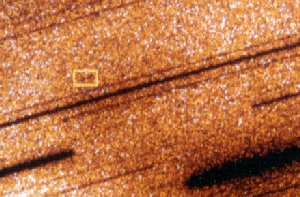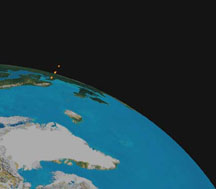Click on image for full size
Courtesy of NASA and the University of Iowa.
Snowballs Entering The Earth's Atmosphere?
News story originally written on June 20, 1997
New evidence has just been found that suggests that there might be such a thing as interplanetary snowballs. And these snowballs are spraying the Earth's atmosphere. NASA's Polar spacecraft is responsible for the findings.
Dr. Louis Frank of the University of Iowa led the team that made the discovery. The research team found that these snowballs could be up to the size of a small house! They are not dangerous to life on Earth, because the snowballs break apart while they are still very far away from the surface of the Earth.
The objects are mostly made up of water. The snowballs may contain organic material, material that supports life. They are thought to be comet-like objects which contain frozen water, and so are termed "dirty snowballs." These snowballs are entering the atmosphere at a rate of 5-30 snowballs per minute, or thousands of snowballs in a given day.
This finding has made the Polar spacecraft's first year in orbit very successful.
Last modified July 18, 2002 by Lisa Gardiner.
You might also be interested in:

Scientists have been working for many years to try and figure out how the Earth first came to have water on it. Now there is a new theory -- the Small Comet theory. Dr. Louis Frank and Dr. John Sigwarth
...more
It was another exciting and frustrating year for the space science program. It seemed that every step forward led to one backwards. Either way, NASA led the way to a great century of discovery. Unfortunately,
...more
The Space Shuttle Discovery lifted off from Kennedy Space Center on October 29th at 2:19 p.m. EST. The weather was great as Discovery took 8 1/2 minutes to reach orbit. This was the United States' 123rd
...more
A moon was discovered orbiting the asteroid, Eugenia. This is only the second time in history that a satellite has been seen circling an asteroid. A special mirror allowed scientists to find the moon
...more
Will Russia ever put the service module for the International Space Station in space? NASA officials want an answer from the Russian government. The necessary service module is currently waiting to be
...more
A coronal mass ejection (CME) happened on the Sun early last month. The material that was thrown out from this explosion passed the ACE spacecraft. The SWICS instrument on ACE has produced a new and very
...more
J.S. Maini of the Canadian Forest Service called forests the "heart and lungs of the world." This is because forests filter air and water pollution, absorb carbon dioxide, release oxygen, and maintain
...more















